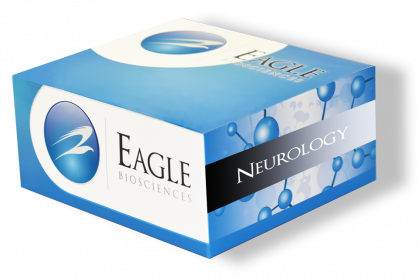beta Amyloid 1-42 ELISA Assay
The beta Amyloid 1-42 ELISA Assay is For Research Use Only
Size: 1×96 wells
Sensitivity:0.29 pg/ml
Dynamic Range: 1.56-100 pg/ml
Incubation Time: Overnight
Sample Type: EDTA-Plasma, cerebrospinal fluid, cell culture supernatant
Sample Size: 100 µL
Alternative Names: Human Aβ42
Assay Principle
This assay employs the quantitative sandwich enzyme immunoassay technique. A monoclonal antibody specific for A 42 has been pre-coated onto a microtiter plate. Standards or samples are pipetted into the wells and any Aβ 42 present is bound by the immobilized antibody. After washing away any unbound substances a HRP-labeled Human Aβ (N) monoclonal antibody is added to each well and incubate. After washing away any unbound reagents, a substrate solution (TMB) is added to the wells and color develops in proportion to the amount of Aβ 42 bound in the initial step. The color development is stopped by the addition of acid and the intensity of the color is measured at a wavelength of 450nm. The concentration of Aβ 42 in the sample is then determined by comparing the O.D of samples to the standard curve.
Related Products
Rodent beta Amyloid 1-40 ELISA
Rodent beta Amyloid 1-42 ELISA
Rodent beta-Amyloid 1-42 Plasma ELISA
Assay Background
Alzheimer’s Disease (AD) is the most common neurodegenerative disorder in elderly people. It has been demonstrated that AD has biological causes and is characterized by the presence of senile plaques and neurofibrillary tangles mainly in cerebral cortex and hippocampus brain regions. Beta-Amyloid (1-40) (Aβ40) and beta-Amyloid (1-42) (Aβ42) are the main components of the above plaques; however, other forms of beta-Amyloid peptides are also present. Both peptides are cleaved from the Amyloid Precursor Protein (APP) by β-secretase and γ-secretase enzymes. Many studies suggest that Aβ42 or/and Aβ43 are required to initiate formation of amyloid plaques and neurofibrills that leads to the neurodegeneration, while Aβ40 is less neurotoxic.
Assay Procedure
1. Remove excess microplate strips from the plate frame, return them to the foil pouch containing the desiccant pack, and reseal it.
2. Add 100 μl of standards, samples and zero controls (Assay Buffer) into wells. Cover the plate and incubate for overnight at 4 °C.
3. Aspirate each well and wash, repeating the process 6 times for a total 7 washes. Wash by filling each well with 1× Wash Buffer (350 μl) using a squirt bottle, manifold dispenser, or autowasher, and keep the wash buffer in the wells for 15-30 sec. Complete removal of liquid at each is essential to good performance. After the last wash, remove any remaining Wash Buffer by aspirating, decanting or blotting against clean paper towels.
4. Add 100 μl 1X HRP-conjugated antibody into each well. Cover wells and incubate for 1 hour at 4°C.
5. Aspirate each well and wash, repeating the process 8 times for a total 9 washes. Wash by filling each well with 1× Wash Buffer (350 μl) using a squirt bottle, manifold dispenser, or autowasher, and keep the wash buffer in the wells for 15-30 sec. Complete removal of liquid at each is essential to good performance. After the last wash, remove any remaining Wash Buffer by aspirating, decanting or blotting against clean paper towels.
6. Add 100 μl of TMB Reagent to each well. Incubate for 30 minutes at RT in the dark.
7. Add 100 μl of Stop Solution to each well. The color of the solution should change from blue to yellow.
8. Read the OD with a microplate reader at 450nm immediately.


